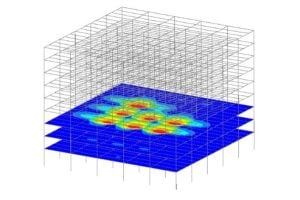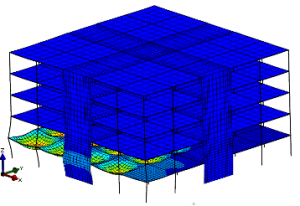
When building a sound structure, a variety of factors are considered including strength, durability, and resistance to fire and heat. To help gauge a structure’s reaction under extreme heat conditions, Thomas Gernay, assistant professor in the Department of Civil and Systems Engineering, and Jean-Marc Franssen of the University of Liege in Belgium developed SAFIR, a computer program that models the behavior of building structures subjected to fire.
The software, available through license-only, allows 3D skeleton models to be created showing beams, columns, slabs, and walls. Volumetric elements can be used for analysis of details in the structure such as connections. Different materials such as steel, concrete, aluminum, gypsum or thermally insulating products can be used separately or in combination in the model.
The major 2022 update to the software is the creation of GmSAFIR, an open-source preprocessor. Building off the base set by the preprocessor Gmsh, GmSAFIR allows licensed SAFIR users to tailor their experience and maximize the effectiveness of their models. It is more user-friendly than the previous graphic user interface, and most importantly, it is open source. Users will be able to configurate the preprocessor and develop their scripts to efficiently build models tailored to their common applications.
“Our community is very important to us,” says Franssen. “With more and more engineers being trained in coding, we can utilize their skills to continuously make updates to the preprocessor, and, ultimately, benefit the entire SAFIR user community.”
The 2022 release of SAFIR includes other notable updates. Developments have improved the interfacing with computational fluid dynamics fire models and reduced computational time in thermal analyses. Updates also include new material models, as the software keeps up with the evolutions in the construction industry and building code committees.
“Our goal is for SAFIR to be a central tool for structural fire engineers,” says Gernay. “To achieve this, we must provide users access to models that are reflective of cutting-edge trends in the construction space while also drawing on our community for important feedback and inspiration.”
SAFIR currently is licensed by more than 250 institutions worldwide, including universities, research centers and design offices. It was used by three out of four firms in a recent ASCE study on performance-based fire design and has been validated against multiple experimental test campaigns on different types of materials, structural elements, structural assemblies and different fire exposures.

Gernay T., Elhami Khorasani N. (2020). “Recommendations for performance-based fire design of composite steel buildings using computational analysis“. Journal of Constructional Steel Research, 166, 105906

Ni S., Gernay T. (2021). “Considerations on computational modeling of concrete structures in fire”. Fire Safety Journal, 120, 103065